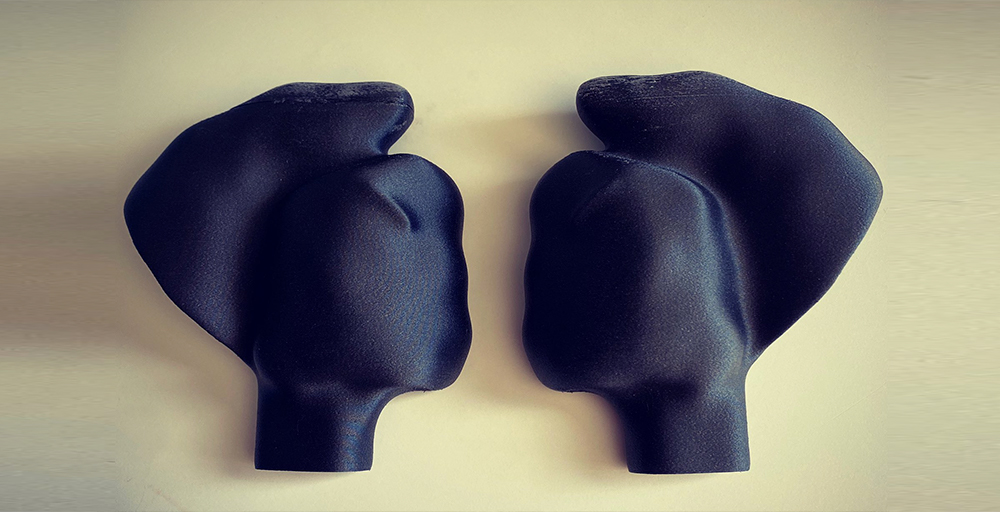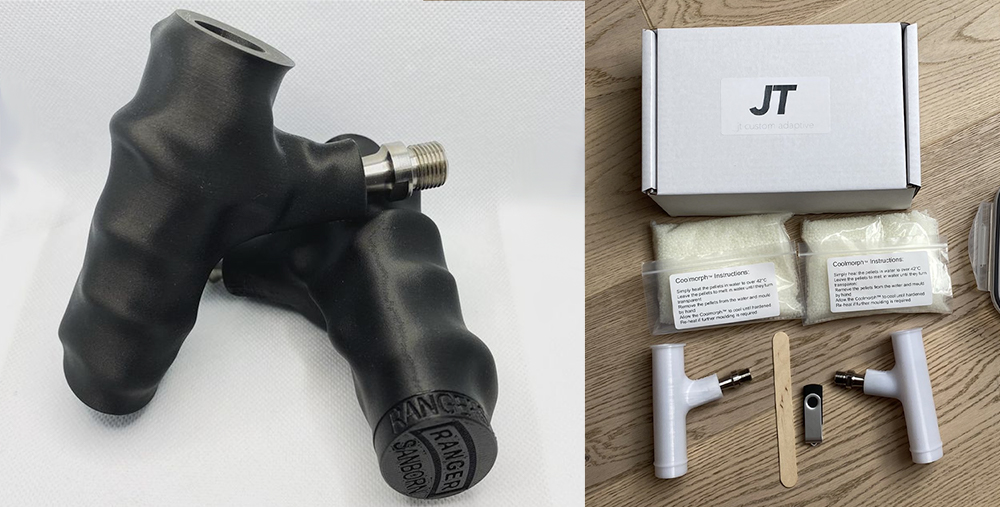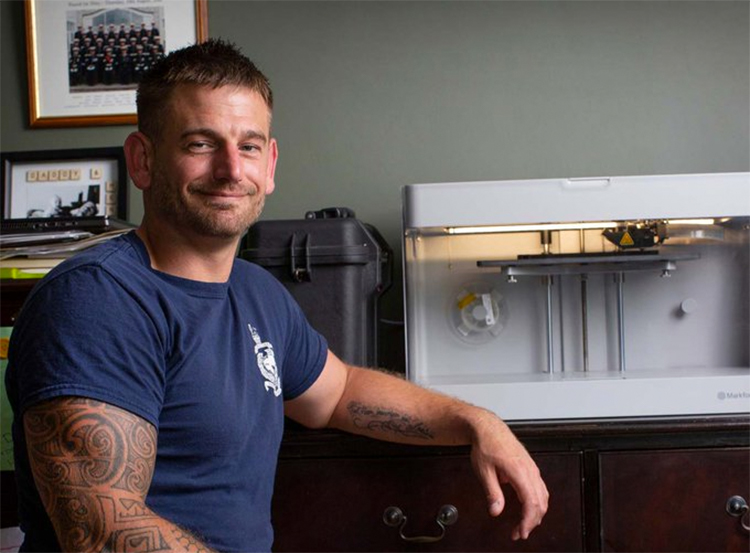Joe Townsend, a world triathlete champion in the Paralympics, World Championships, and Ironmans, is one exceptional example of the potential 3D printing has on sports equipment performance.
Ever since he lost his legs in Afghanistan as a royal marine commando, Joe earned a successful career, not just as a parathlete, but as a keen innovator designing and manufacturing custom-fit 3D printed grips and adaptive equipment to advance parathletic performance. His small manufacturing endeavor has created 3D printed equipment for a host of amateur and professional athletes including the 2021 Americas Triathlon Para Championship winner Howie Sanborn.

Having gear at optimum performance in these though competitions makes the difference, and even if it is by just a few seconds, every second in a race counts. As a triathlete, Joe not only deals with one category of adaptive equipment but two: A racing wheelchair and a handbike.
The Challenges Paralympic Athletes Face
So, what is the basic stuff an athlete must think about when it comes to equipment performance? Optimum strength-to-weight ratio, aerodynamics and adaptability are evident when it comes to racing purposes; however, the third one is particularly challenging. Since every athlete is a unique case, adaptative equipment requires extensive trial and error cycles, leading to high R&D costs. Most athletes, especially adaptive, must deal with major investment if they want to have a minimal competitive edge. According to Joe, his equipment surpasses the 25 grand in costs.
Now, custom equipment is not only a money issue; it is also vital in terms of health and comfort. For both hand cycling and wheelchair racing, long periods of high-speed revolutions can slowly grind cartilage and muscle tissue, particularly at Joe’s professional level. For example, if a crankarm is either too short or too long and the attack angle is not the right one, it can cause harmful effects on the athlete’s shoulder. Joe had to deal with this issue personally when he had a shoulder reconstruction surgery back in 2014.

Joe’s Solutions
Joe found several problems with the current equipment on the market, which ultimately led him to produce bespoke adaptive parts in-house that naturally led him to 3D printing. As a self-taught 3D printing user, Joe is well aware of its potential for short-run custom part production and adjusted for every athlete’s needs.
He experimented with standard PETG printing in his first trials; however, it didn’t meet the requirements. Joe needed to expand his capabilities to print high strength end-use parts, so that’s when he reached out to SolidPrint3D. Instantly, the staff came up with a straight answer: Markforged’s reinforced printing. So, they guided him on how the reinforcement process works and which machine to choose based on informed decisions. He even sent his files to the SolidPrint3D team and they provided him back with sample parts, which he tested himself to see their strengths. Subsequently, he bought the Markforged Mark Two model, the most suitable option for his needs.
Now Joe employs durable Markforged materials like Onyx which he reinforces with continuous fibers, typically carbon fibre. So now he can achieve:
- High mechanical performance
- Instantaneous manufacture of parts that quickly adapt
- Design flexibility
- Costs reduction
- Aesthetically pleasing finishes

Custom Crankarm
As we pointed out, having a crankarm with the right length and right offset angles is vital, not just in terms of performance but also in health and comfort. Joe can maximize dimensional performance by editing the CAD model’s parameters and then print it at home whenever he wants or needs. Furthermore, his Markforged carbon-reinforced printed parts offer a weight-to-stiffness ratio that welded aluminium could never hope to accomplish.
So how does he implements his reinforcements? Fibre continuity and orientation are critical in composite manufacturing. First of all, continuity is not a problem for the Mark Two’s CFR system, which performs flawlessly; the vital decision to take here is how to apply those reinforcement paths. It all depends on the forces involved in the cycling process. And, where are the critical stresses in a handbike’s crankarm? Well, this crankarm deals with high flexural stresses throughout its length and from all directions all over the spider. Therefore, the best fibre distribution is that which is applied axially throughout the crankarm.

Custom Gloves & Handles
When it comes to wheelchair racing, gloves are an essential part, if not the most. Consequently, athletes look up to optimize and maximize performance by adapting them to the shapes of their hands. One of the most common ways to produce custom gloves is by moulding Polymorph thermoplastic pellets by hand. Every detail on the glove’s surface makes the difference in terms of rim-glove contact effectiveness.
Glove moulding has become an art in and of itself, which wouldn’t be a problem if gloves were long-lasting. However, it is usual for athletes to lose or to break them during competitions. So, having to do the whole moulding process all over again not only takes time but also does not guarantee consistency in relation to the previous one. Thankfully, 3D printing has become a game-changing option where the athlete’s handprint can be stored in a digital database and thus maintaining spares with geometrical consistency becomes possible.
Although there are some people already using 3D printed gloves made out of PLA, PETG and ABS, those gloves break easily; Joe personally tried those materials before opting for Markforgred printed parts. Now, with his new printing capabilities, he has made a whole spare collection uniquely adapted for any condition he may face. For instance, he uses stiffer gloves in competitions for better performances and, alternatively, softer gloves while training, which is more comfortable and less prone to cause injury. He even adapts his gloves for different weathers, one set for humid situations and another when it’s dry.
As you can see, Joe managed to significantly improve the ergonomics of his glove collection with the flexibility 3D printing offers. Is it possible to apply the same principle to his handbike grips? The answer is yes!

JT Custom Adaptive
Joe had personal issues adapting to existing equipment, so he could understand that other athletes might face the same too. Given his success with 3D printing, he shared the need to recreate what he has been doing with universities and businesses. Still, people were uninterested, incapable, or the price was too prohibiting. Consequently, he created JT Custom Adaptive, his entrepreneurship to provide personalized parts for athletes at much lower costs.
The process for both custom gloves and handgrips is quite similar. First, Joe sends a kit with instructions and a pack of Polymorph pellets to his customers, among other accessories. Then, the customers can mould the grip to the shape of their hands or any other desirable shape with the help of a heat gun or hot water. After the part cools down and hardens, they send it back to Joe. He then uses a 3D scanner to digitalize and store a 3D replica of the mould into his computer, where he makes some edits and cutouts before printing. Lastly, after doing some extra postprocessing like inserting threaded joints (In the case of the handgrips), he then ships the final product back to the customer.
Until now, business has been successful, and customers are demanding shipments worldwide. With that said, Joe clearly expresses his excitement for further possibilities and improvements for hand bikes and racing wheelchairs with the benefits of 3D printing.
For more information on Joe Townsend and his JT Custom Adaptive project, email jtcustomadaptive@gmail.com for information and order forms or check his profiles at:
- Instagram: @joetownsendtri
- Twitter: @Joetownsend1664
About the Author: Alejandro Auerbach is a mechanical engineer specializing in additive manufacturing at Solid Print3D.
License: The text of "Paralympic Athlete 3D Prints Adaptive Sports Equipment" by All3DP Pro is licensed under a Creative Commons Attribution 4.0 International License.